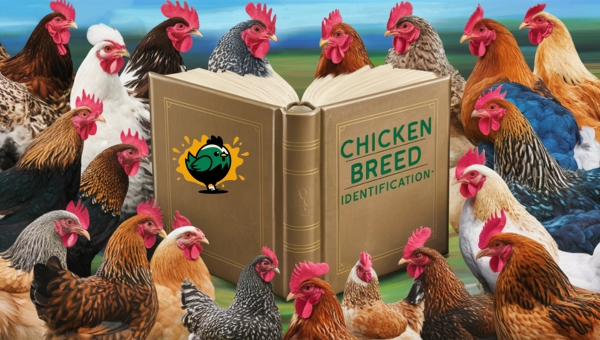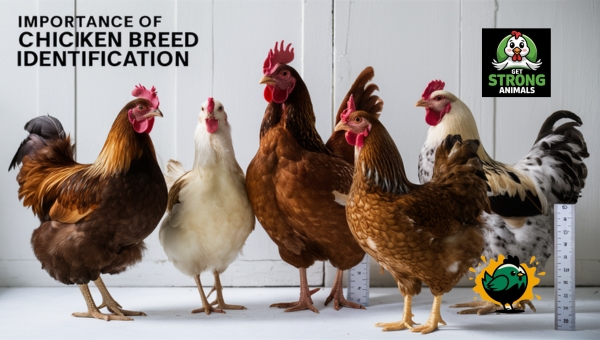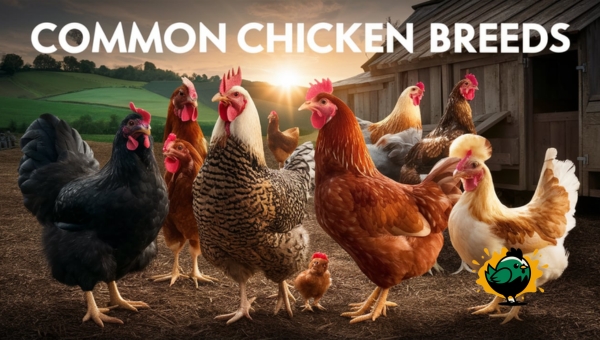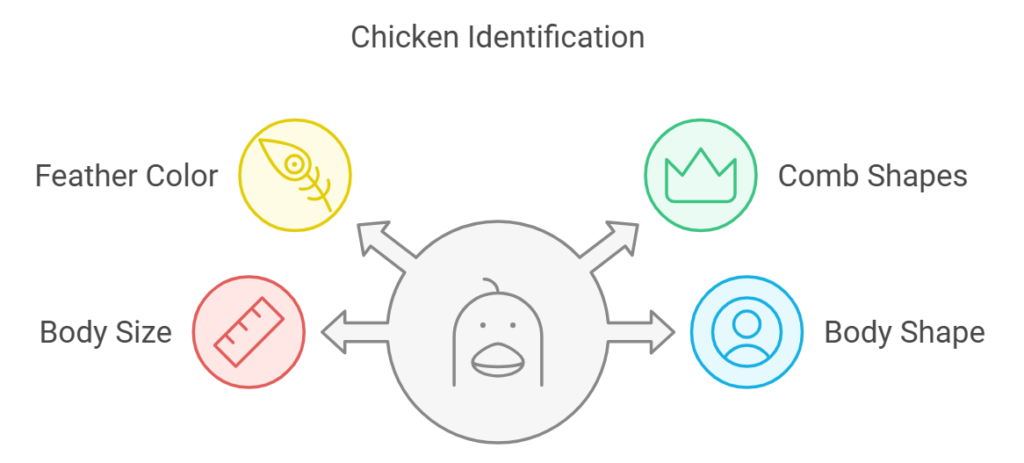Chicken Breed Identification | Find Your Perfect Match

Imagine you’re in your backyard, watching your chickens peck around. You notice some have strikingly different features. Ever wondered what breed they are? Chicken breed identification isn’t just a fun guessing game; it’s a vital skill for any poultry enthusiast.
Different breeds have distinct characteristics that can affect everything from egg production to temperament. Knowing your breed helps you cater to their needs better. This article will guide you through the fascinating world of chicken breeds.
We’ll explore their physical traits, behaviors, and the tools you can use for accurate identification. Dive in, and let’s unlock the secrets of your flock together!
Importance Of Chicken Breed Identification
Understanding chicken breed identification is vital for successful poultry management. Recognizing different breeds allows farmers to optimize production by selecting chickens best suited to their specific needs, whether for egg production, meat quality, or adaptability.

Each breed has unique traits, such as temperament and egg-laying patterns, which affect their care and management. Selecting the right breed can lead to better animal welfare, as it ensures that chickens’ specific needs are met, fostering a healthier environment.
Additionally, knowing the breed helps in conserving heritage breeds and maintaining biodiversity, which can be crucial for long-term sustainability and productivity in farming operations.
Common Chicken Breeds
Chicken breeds are as varied as they are fascinating, each bringing unique traits to the table. Whether you’re interested in the rich history of heritage breeds or the practicality of modern hybrids, there’s much to discover.

Let’s take a look at some of the popular heritage breeds and the modern hybrid varieties that are prevalent in today’s poultry farming.
Popular Heritage Breeds
Exploring heritage breeds reveals a world of chickens with a history and distinct characteristics:
- Rhode Island Reds: Known for their hardiness and consistent egg-laying abilities, making them a favorite among many farmers.
- Orpingtons: Valued for their friendly nature and versatility, these birds are often dual-purpose, suitable for both eggs and meat.
- Plymouth Rocks: Recognizable by their striking black-and-white pattern, they are known for being reliable layers and adaptable to various conditions.
- Sussex: With origins tracing back centuries, they are cherished for their calm temperament and excellent egg production.
Modern Hybrid Varieties
Modern hybrid chickens are designed for efficiency and productivity, often surpassing traditional breeds:
- ISA Browns: Engineered for high egg production, these hens are prolific layers with a gentle disposition.
- Red Rangers: Bred for meat production, they grow rapidly and produce a quality carcass.
- Amberlinks: Known for their efficient feed conversion and high egg output, making them a sustainable choice for egg farms.
- Cobb 500: A leading broiler breed, prized for its fast growth rate and meat quality.
These breeds, each with their unique characteristics, provide options for various farming objectives, whether it’s for egg production, meat, or dual-purpose use.
Also Read: Keep Chickens Cool in Summer – Top Tips for a Healthy Flock
Physical Characteristics For Identification
Identifying chicken breeds can be fascinating, and physical traits provide valuable clues. By examining features such as feather color, combs, wattles, and size, enthusiasts can recognize different breeds. These characteristics are like puzzle pieces that fit together to reveal the unique identity of each chicken breed.

Feather Color And Patterns
Feather color and patterns are vital for distinguishing chicken breeds. They act as visual identifiers, allowing for easy recognition.
- Unique Colors: Some breeds have distinct feather colors, like the white feathers of Leghorns or the black and white patterns of Plymouth Rocks.
- Markings: Patterns such as speckles or lacing can help differentiate breeds, making it easier to identify them visually.
Combs And Wattles
Combs and wattles are important features that vary among chicken breeds. They serve as indicators for breed identification.
- Comb Shapes: Different breeds have unique comb shapes, such as single combs in Rhode Island Reds or rose combs in Wyandottes.
- Wattle Size: Wattles also differ in size and shape, contributing to the identification of specific breeds.
Size And Shape
Size and shape are essential in identifying chicken breeds. These physical differences can aid in recognizing various breeds.
- Body Size: Breeds like Jersey Giants are larger, while Bantams are smaller, helping to distinguish between them.
- Body Shape: The shape of a chicken, including features like the back and tail, can indicate its breed, providing valuable identification cues.
Behavioral Traits And Habits
Understanding the behavioral traits and habits of chickens is essential for anyone interested in chicken breed identification. Each breed exhibits unique behaviors that can provide valuable insights into their identification.
By analyzing these characteristics, one can better distinguish between different breeds. This section will delve into two primary aspects: temperament and egg-laying patterns, both crucial for identifying chicken breeds.
Temperament
- Chickens are known for their diverse temperaments, which can vary significantly among breeds.
- Some breeds are naturally docile and enjoy human interaction, making them ideal for backyard settings.
- Other breeds may be more independent or aggressive, preferring less human contact.
- Understanding these temperament differences can help in selecting the right breed for specific environments and purposes.
Egg-Laying Patterns
- Frequency: Some breeds are prolific layers, producing eggs almost daily, while others lay less frequently.
- Egg Color: The color of eggs can vary by breed, with some laying brown eggs and others white or even blue.
- Seasonal Variations: Certain breeds may only lay eggs during specific seasons, influenced by daylight and weather conditions.
- Consistency: The regularity of egg production can also be a distinguishing factor, with some breeds maintaining consistent output year-round.
By observing these traits, enthusiasts and farmers can make informed decisions about breed identification and management.
Tools And Techniques For Accurate Identification
Recognizing chicken breeds can sometimes be challenging, yet it is important for effective poultry management. Fortunately, there are several tools and techniques available that can assist in this process.
From visual aids to advanced genetic methods, these resources can help enthusiasts and farmers alike discern between the myriad of chicken breeds. Let’s delve into some of the most effective methods used today.
Visual Identification Guides
Visual identification guides serve as a fundamental resource for those eager to pinpoint specific chicken breeds.
These guides typically feature:
- Clear Illustrations: Detailed images of various breeds, showcasing their unique features.
- Descriptions: Textual explanations of breed-specific traits, such as feather colors and comb shapes.
- Comparative Analysis: Side-by-side comparisons to highlight differences between similar breeds.
Genetic Testing And DNA Profiling
For those seeking precision, genetic testing, and DNA profiling offer cutting-edge methods to confirm chicken breed identities.
These advanced techniques include:
- DNA Sampling: Collecting genetic material from chickens to analyze their breed lineage.
- Laboratory Analysis: Utilizing specialized equipment to interpret DNA sequences.
- Accurate Results: Providing definitive identification, even in cases where visual characteristics might overlap.
By employing these tools and techniques, individuals can gain a deeper understanding of chicken breed identification, aiding both hobbyists and professionals in their endeavors.
Also Read: Backyard Chicken Keepers Mistakes | Avoid These Pitfalls
Challenges In Chicken Breed Identification
Identifying chicken breeds can be a complex endeavor for several reasons. Here are some common challenges faced while trying to distinguish between different breeds:
- Similar Features: Many chicken breeds share overlapping physical traits, making it difficult to differentiate between them. Subtle differences in size, color, and shape can be challenging to spot, especially for beginners.
- Hybridization: The practice of crossbreeding chickens to produce hybrids further complicates identification. These hybrid chickens often exhibit mixed characteristics that are not typical of any single breed, adding to the confusion.
- Limited Resources: Access to comprehensive and reliable guides or tools for chicken breed identification may be limited. Without these resources, accurately identifying breeds can become a daunting task.
- Environmental Influences: Environmental factors can sometimes alter the appearance of chickens, such as feather color and condition, which may lead to misidentification.
- Lack of Standardization: There is often a lack of uniform standards for breed characteristics across different regions, which can lead to inconsistencies in breed identification.
These challenges highlight the complexity involved in chicken breed identification and underscore the importance of utilizing multiple methods and resources to achieve accurate results.
FAQs
Why is it important to identify chicken breeds?
Identifying chicken breeds is vital for efficient poultry management as it helps optimize egg production, meat quality, and overall health. It ensures that specific farming goals are met by selecting the right breed.
What role do combs and wattles play in breed identification?
Combs and wattles vary among chicken breeds, providing visual clues. Their distinct shapes and sizes can indicate specific breeds, aiding in identification.
Can temperament indicate a chicken’s breed?
Yes, temperament is a useful trait for identifying chicken breeds. Different breeds exhibit varied temperaments, ranging from docile and friendly to more independent or aggressive.
Conclusion
Understanding chicken breed identification plays a vital role in poultry management. By recognizing the unique features and behaviors of various breeds, farmers can make informed decisions to enhance productivity and animal welfare.
Whether you’re dealing with heritage breeds or modern hybrids, knowing the specifics helps in selecting the right breed for your needs. Employing tools and techniques, from visual guides to genetic testing, ensures accurate identification. Overcoming challenges in identification is essential for successful poultry farming.
Interested in learning more about poultry management and other related topics? Explore our site for more insightful articles!
